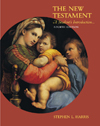|
 |  The New Testament, 4/e Stephen Harris,
California State University - Sacramento
The Gospels: Form and Purpose
Web Links
The Synoptic Problem Home Page
(http://www.mindspring.com/~scarlson/synopt/)
The Synoptic Problem Home Page
A comprehensive and quite scholarly survey of all dimensions of the Synoptic Problem. Includes diagrams of all of the leading solutions to the problem suggested by scholars over the years. Also includes external testimony concerning the authorship of the Synoptics from ancient church fathers and a very comprehensive bibliography. |
 |  |  | The Synoptic Gospels Primer
(http://religion.rutgers.edu/nt/primer/)
Maintained by Mahlon Smith of Rutgers University, this Web site is designed for college students who are studying the synoptic problem for the first time. It contains many of the same features as the Synoptic Problem Home Page, but, it does not provide the original Greek for the source materials it quotes as the above site does. |
 |  |  | The Two Gospel Hypothesis
(http://www.colby.edu/rel/2gh/)
A Web site maintained by a team of scholars devoted to the Two Gospel Hypothesis (formerly known as the Griesbach Hypothesis). Includes an analysis of the synoptic gospels in the original Greek in a manner illustrating the hypothesis. Also includes numerous articles by William Farmer, one of the foremost proponents of the Griesbach Hypothesis. |
 |  |  | Mark Without Q: A Synoptic Problem Web site
(http://www.bham.ac.uk/theology/q/)
This site, maintained by Mark Goodacre, presents the intriguing thesis, known as the Farrer Theory, that Q is an unnecessary element in understanding Synoptic Gospel relationships. |
 |  |  | The Story of the Storytellers
(http://www.pbs.org/wgbh/pages/frontline/shows/religion/story/)
This is a section of the wonderful PBS Frontline Web site for the special From Jesus to Christ. This section of the Web site provides a brief introduction to the literary processes that resulted in our four Gospels. |
 |  |  | The Search for the No-Frills Jesus
(http://www.theatlantic.com//issues/96dec/jesus/jesus.htm)
This article from Atlantic Monthly is an informed yet detailed summary of the Synoptic Problem and how it continues to fuel contemporary scholarly debate about who Jesus was. |
|
|



 2002 McGraw-Hill Higher Education
2002 McGraw-Hill Higher Education